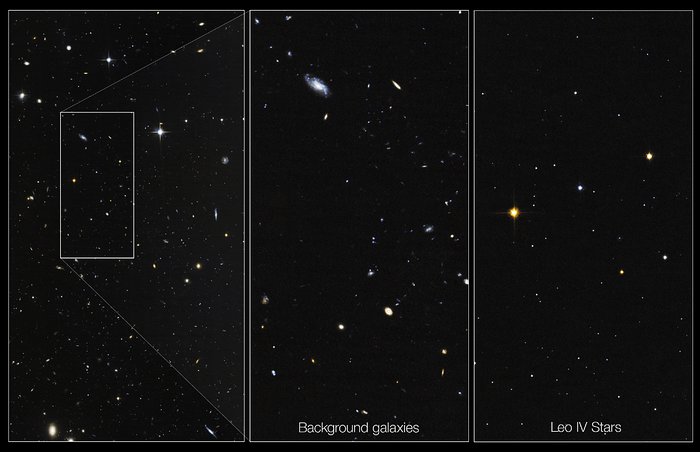Hubble probes ‘ghost’ galaxy
Astronomers used the NASA/ESA Hubble Space Telescope to unmask the dim, star-starved dwarf galaxy Leo IV. These Hubble images demonstrate why astronomers had a tough time spotting this small-fry galaxy.
The image at left shows part of the galaxy, outlined by the white rectangular box. The box measures 83 light-years wide by 163 light-years long. The few stars in Leo IV are lost amid neighboring stars and distant galaxies.
A close-up view of the background galaxies within the box is shown in the middle image.
The image at right shows only the stars in Leo IV. The galaxy, which contains several thousand stars, is composed of Sun-like stars, fainter, red dwarf stars, and some red giant stars brighter than the Sun. Astronomers discovered Leo IV in Sloan Digital Sky Survey images by spotting a region where a clump of stars was huddled closer together than stars in areas around it.
Residing 500 000 light-years from Earth, Leo IV is one of more than a dozen ultra-faint dwarf galaxies found lurking around our Milky Way galaxy. These galaxies are dominated by dark matter, an invisible substance that makes up the bulk of the Universe’s mass.
Credit:NASA, ESA, and T. Brown (STScI)
About the Image
| Id: | heic1211b |
| Type: | Collage |
| Release date: | 10 July 2012, 19:00 |
| Related releases: | heic1211 |
| Size: | 2916 x 1881 px |
About the Object
| Name: | Leo IV dwarf galaxy |
| Type: | Local Universe : Galaxy : Size : Dwarf |
| Distance: | 500000 light years |
| Category: | Galaxies |
Colours & filters
| Band | Wavelength | Telescope |
|---|---|---|
| Optical V | 606 nm |
Hubble Space Telescope
ACS |
| Optical i | 814 nm |
Hubble Space Telescope
ACS |
